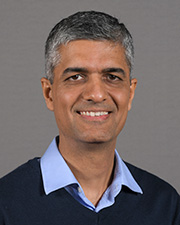
Ashish Kapoor, PhD
- Associate Professor, IMM-Center for Human Genetics
- Jerry and Maury Rubenstein Foundation Distinguished Professor in Heart Disease Research
Biography
Ashish received his bachelor’s and master’s degrees from University of Delhi, Delhi. He carried out his doctoral work in the laboratory of Anuranjan Anand at the Jawaharlal Nehru Centre for Advanced Scientific Research, Bangalore and his postdoctoral work in the laboratory of Aravinda Chakravarti at the Johns Hopkins University School of Medicine, Baltimore, where he continued working as a Research Associate before joining the Institute. His research focuses on understanding how sequence variation in cis-regulatory elements controlling gene expression leads to phenotypic variation (disease risk and trait variation) and utilizes electrocardiographic QT interval as a model quantitative trait.
Research Profile: Understanding the role of variable gene expression driven by non-coding cis-regulatory sequence variation in disease/trait risk
Variation in gene expression regulation, largely due to sequence variation in non-coding cis-regulatory elements (CREs), has been a key to development and evolution across species, primarily through trait variation within a species. In humans, for example, genome-wide association studies (GWAS) have beyond doubt established a major role for variable gene expression as the basis for trait variation and disease risk. However, the specific molecular components and structure of this regulatory apparatus underlying gene expression variation in humans remains largely unknown and is our primary research focus.
We utilize electrocardiographic QT interval as a model quantitative trait for mechanistic understanding of complex traits/diseases. QT interval, with a heritability of 35%, is a clinically relevant quantitative trait as its prolongation or shortening is associated with an increased risk of cardiovascular morbidity and mortality, primarily in the form of cardiac arrhythmias leading to sudden cardiac death (SCD), which is the leading cause of deaths in US. A major reason for studying the QT interval regulation is to understand the genetic risk factors for SCD in the general population. Genetic variation is a major source of QT interval variation and GWAS of the QT interval in the general population have identified at least 35 loci that together explain ~10% of the phenotypic variance. Our research goal is to understand the molecular basis of these observed genetic associations.
In order to perform the molecular characterization of GWAS signals, our research involves identification of the CREs whose functions are altered by disease/trait associated variants (causal variants), the transcription factors whose bindings are disrupted at the CREs due to causal variants, the target gene whose expression is modulated, and then linking the perturbation of target gene expression to a trait/disease relevant cellular or organismal phenotype. We utilize a wide variety of genetic, biochemical, cellular, functional genomic and computational approaches and apply them on a locus-by-locus basis to identify each of these components.
Publications
Gunamalai L, Singh P, Berg B, Shi L, Sanchez E, Smith A, Breton G, Bedford MT, Balciunas D, Kapoor A. Functional characterization of QT interval associated SCN5A enhancer variants identify combined additive effects. Human Genetics and Genomics Advances 2024; 6:100358
Smith A, Auer D, Johnson M, Sanchez E, Ross H, Ward C, Chakravarti A, Kapoor A. Cardiac muscle-restricted partial loss of Nos1ap expression has limited but significant impact on electrocardiographic features. G3 Genes|Genomes|Genetics 2023; 13:jkad208
Chatterjee S, Karasaki KM, Fries LE, Kapoor A, Chakravarti A. A multi-enhancer RET regulatory code is disrupted in Hirschsprung disease. Genome Research 2021; 31:2199-2208
Kapoor A, Nandakumar P, Auer DR, Sosa MX, Ross H, Bollinger J, Yan J, Berrios C, The HDRC Consortium, Chakravarti A. Multiple, independent, common variants at RET, SEMA3 and NRG1 gut enhancers specify Hirschsprung disease risk in European ancestry subjects. Journal of Pediatric Surgery 2021; 56:2286-2294.
Lee D, Kapoor A, Lee C, Mudgett M, Beer MA, Chakravarti A. Sequence-based correction of barcode bias in massively parallel reporter assays. Genome Research 2021; 31:1638-1645.
Kapoor A, Lee D, Zhu L, Soliman EZ, Grove ML, Boerwinkle E, Arking DE, Chakravarti A. Multiple SCN5A variant enhancers modulate its cardiac gene expression and the QT interval. Proceedings of the National Academy of Sciences 2019; 116:10636-10645
Lee D, Kapoor A, Safi A, Song L, Halushka MK, Crawford GE, Chakravarti A. Human cardiac cis-regulatory elements, their cognate transcription factors and regulatory DNA sequence variants. Genome Research 2018; 28:1577-1588
Kapoor A, Auer DR, Lee D, Chatterjee S, Chakravarti A. Testing the Ret and Sema3d genetic interaction in mouse enteric nervous system development. Human Molecular Genetics 2017; 26:1811-1820
Chatterjee S, Kapoor A, Akiyama JA, Auer DR, Lee D, Gabriel S, Berrios C, Pennacchio LA, Chakravarti A. Enhancer variants synergistically drive dysfunction of a gene regulatory network in Hirschsprung disease. Cell 2016; 167:355-368
Kapoor A, Bakshy K, Xu L, Nandakumar P, Lee D, Boerwinkle E, Grove ML, Arking DE, Chakravarti A. Rare coding TTN variants are associated with electrocardiographic QT interval in the general population. Scientific Reports 2016; 6:28356
Kapoor A, Jiang Q, Chatterjee S, Chakraborty P, Sosa MX, Berrios C, Chakravarti A. Population variation in total genetic risk of Hirschsprung disease from common RET, SEMA3 and NRG1 susceptibility polymorphisms. Human Molecular Genetics 2015; 24:2997-3003
Kapoor A, Sekar RB, Hansen NF, Fox-Talbot K, Morley M, Pihur V, Chatterjee S, Brandimarto J, Moravec CS, Pulit SL, QTIGC, Pfeufer A, Mullikin J, Ross M, Green ED, Bentley D, Newton-Cheh C, Boerwinkle E, Tomaselli GF, Cappola TP, Arking DE, Halushka MK, Chakravarti A. An enhancer polymorphism at the cardiomyocyte intercalated disc protein NOS1AP locus is a major regulator of the QT interval. American Journal of Human Genetics 2014; 94:854-869
Auer DR, Sysa-Shah P, Bedja D, Simmer JL, Pak E, Dutra A, Cohn R, Gabrielson KL, Chakravarti A, Kapoor A. Generation of a cre recombinase-conditional Nos1ap over-expression transgenic mouse. Biotechnology Letters 2014; 36:1179-1185